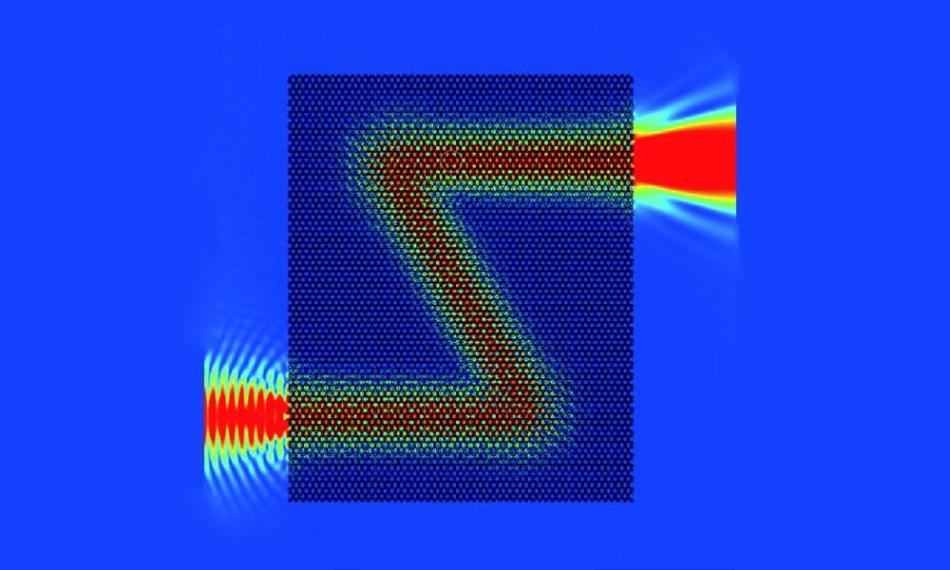Mar 6 2019
The Universidad Carlos III de Madrid (UC3M) is participating in a study, which examines the prospect of topological insulators utilizing sound waves—that is, materials that act similar to acoustic insulators in their interior and yet simultaneously enable sound waves to move at their surface.
 This research analyzes the future of topological insulators using sound waves (acoustic insulators inside, sound waves conductors on their surface). (Image credit: UC3M)
This research analyzes the future of topological insulators using sound waves (acoustic insulators inside, sound waves conductors on their surface). (Image credit: UC3M)
This kind of study can potentially enhance medical diagnostics and acoustic non-destructive testing based on ultrasound scans.
In structures like these, sound signals continue to be strong and unresponsive to noise brought about by defects and impurities present in the material. Within the context of this study, the researchers have found that the acoustic topological insulator can potentially behave as a highly powerful waveguide, with the ability to radiate sound in an extremely narrow ray towards the far field. As pointed out by the scientists, applications like diagnostic ultrasound scans in biology and medicine or non-destructive testing by ultrasound could considerably benefit from this focused acoustic ray.
In the article, which has been recently reported in the journal Communications Physics together with physicists from the Stanford University (US) and the University of Nanjing (China), the researchers have assessed the latest studies with regards to the advancement of this topic associated with quantum physics. This kind of study has won the Nobel Prize in Physics 2016 and remains at the forefront of physics. The team who conducted this research wanted to find out if the occurrence of topological insulators—conventionally utilized in quantum physics to regulate electrical signals—could have a corresponding effect utilizing sound waves.
The idea was to use a concept so exotic it could produce completely new possibilities for acoustic transducers, sensors and waveguides. Moreover, from a more physical perspective, it would mean that certain effects in quantum physics have an equivalent in classic sound wave physics.
Johan Christensen, Study Co-Author, Department of Physics, UC3M
For this, the scientists wanted to imitate what is known as the “valley-Hall effect”, employed for studying electrical conduction in a variety of different semi-conductive and conductive materials. Under this effect, the magnetic field isolates the negative charges from the positive charges in reverse directions, and hence, the “valleys” are minimums and maximums of electron energy in a crystal solid. When the force applied by the magnetic field is opposed by the force applied by the electric field created by the distribution of charges, the balance is restored.
Taking inspiration from the weaving of Japanese baskets called “kagome”, the team developed an artificial macroscopic crystal, replacing the bamboo for tiny cylinders of epoxy resin. The researchers’ goal is to imitate an acoustic form of this valley-Hall effect,
The previous year, Johan Christensen had published a number of articles in the scientific journals, Physical review letters and Advanced materials, which elucidated the operation of this crystal.
Curiously, the acoustic topological states related to the valley-Hall effect show a circulating vortex which, to our surprise, has produced unexpected and unprecedented properties for acoustics. Our Kagome crystal showed incredible resistance against pronounced defects, curves and turns when guiding the sound over the surface or interface of the crystal.
Johan Christensen, Study Co-Author, Department of Physics, UC3M
This kind of study is being advanced as part of a broader scientific project, an ERC Starting Grant Horizon 2020 funded by the European Union (GA 714577) called “Frontiers in Phononics: Parity-Time Symmetric Phononic Metamaterials” (PHONOMETA). In this milieu, its goal is to examine and create an innovative range of piezoelectric semiconductors, which enable the optimization of the functioning of intricate acoustic systems.
(TEASER) UC3M researches the limits of topological insulators using sound waves
Video credit: UC3M